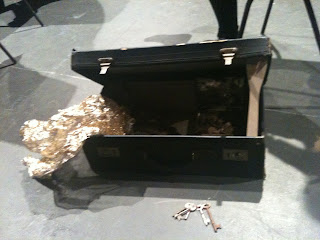At first the letters were collected together and stuck onto a piece of paper. I personally felt that this was too contained and manageable and neat to show a guilty conscience and so we then wrote more letters and bulked the shape out, having scrunched up pieces of paper and lose letters. I felt that having them glued down just wasn't realistic enough for me and that with a bigger mass of letters and paper they should look like they have mounted over time and accumulated over time.
We struggled with the suitcase, we felt that it was too old and out of place in the office enviroment. We changed over to a brief case which went with the whole office feel and brought everything together.
By having letters in the case it brought the theme together across the table and down onto the floor.
Our projections worked well. We did have to re-film the movements, Laura's black trousers did not show up in the projection because we had first used a black screen and they were not visible. We then changed the colour of the trousers which enabled us to see the whole image.
We added a desk lamp to highlight the letters, we did this to show the guilt ridden and emotion filled letters, they were visible to the audience and able to be read.
The final finished installation looked like this...
The purple lighting added to the feeling and made the scene look a little nauseous and like somewhere that is private.
The miniature human projections in the jars worked well, we decided to the change the black paper to brown and found that this connected nicely to the letters and paper on the desk and floor.

Feedback:
- People enjoyed looking at the jars and the miniature image visible.
- They liked the idea of the letters and how they appeared and were displayed saying that it give a powerful visual impact.
- The OCD of the desk and the contrast of the out of control letters was a clear visual message.
- The audio, which we recorded, played in the room whilst it was silent, was quite strong and gave a big impact on the control and destruction.
- The lighting was enough to highlight the piece but not deform or fade the projection.
- Although we did not want the laptop in the installation we managed to make it so that the laptop and the projector integrated into the scene as office material and in use.
- Hand written letters are effective and give it stronger feeling of guilt.
Things to improve on:
- Some tutors felt that a performance piece would have improved the overall feel of the installation. (however as a group we thought that having a performance part in it, the attention of the audience would not be focused on the audio or the projection.) Although we had previously thought about the idea of our piece being a performance and didn't carry through with it, to have a better understanding of how it would work, we should have experimented by using other members of the class to get their opinion on the matter.
- We could have made more of the OCD aspect of the piece by using a bigger desk to display the desk and its arrangement.
- In hindsight we would have liked to have continued on our original idea which after many different directions we ended back at. This would have saved time, stress and confusion.
- For the presentation of the groups installations pieces, our piece was place third in the running order. Unfortunately that meant that the two pieces before ours gave an expectation to our pieces which it just didn't need. In hindsight again it should have been first as to not lead the audience on to expect something similar to the two group before.
- I personally would have liked to have more letters, on a large quantity and have them flowing out from beneath the desk, down the table, out from the briefcase and fill a large amount of room. To have such a quantity so that the audience have to walk through the piece, on the paper, kicking it as they walk through to get to the table and have a closer look at the main piece.
Technical Issues:
- Blind spot - Laptop blocked a direct view of the piece.
- Spot light on desk did not make too much of a difference.
- Laptop was in the way, we would have preferred that the Laptop had been hidden from view.























